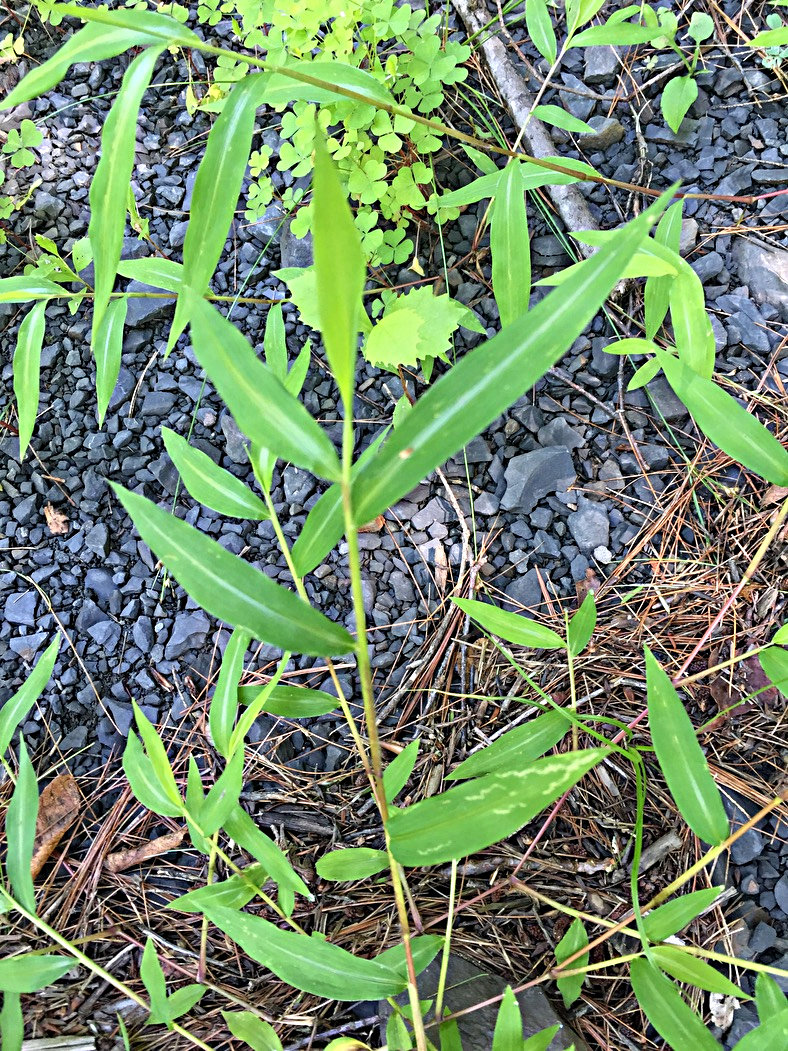 Here is some information to get you started about controlling it. It seems to be everywhere now in Sussex County.
Here is some information to get you started about controlling it. It seems to be everywhere now in Sussex County.
What is it?
Japanese stiltgrass (Microstegium vimineum) is an annual grass with a sprawling habit. It is a colonizing species that spreads quickly during the summer and fall. Individual plants may produce 100 to 1,000 seeds that drop in the late summer and germinate the following spring. Seed may be carried further by water currents during heavy rains or moved in with contaminated hay, soil, potted plants, construction fill, footwear and on the tires of vehicles. Stiltgrass seed remains viable in the soil for five years and germinates readily when hit by sunlight. When the plant dies it leaves a thick layer of thatch because the stems are slow to decompose and the density can suffocate other plants in its path. The seed itself is allelopathic which means it produces a chemical that suppresses the gemination of other types of seed, thus turning biodiverse areas into stiltgrass monocultures.
Where did it come from?
It was sent to the US in the early 20th century in the form of packing material from Asia. The dried grass was used to pack imported dishes and household goods. It first showed up as a problem in Tennessee and has since spread across the US.
Why is it a problem?
An invasive plant is basically one that harms the eco-system in which it arrives. Stiltgrass is an ecological threat because it spreads to form dense extensive patches, thus displacing many other species that are not able to compete with it. Deer do not eat stiltgrass and by selectively feeding only on surrounding plants they help the stiltgrass become a monoculture. The interaction between stiltgrass and the Northern Pearly Eye (Enodia anthedon) butterfly is being studied because its caterpillar eats only native grasses. The butterfly was once common, but it's been observed that their populations crash when stiltgrass enters the environment. Further investigation is being done to study the potential impacts of stiltgrass on grass dependent butterflies and other insects that might try to utilize stiltgrass as an alternative host plant.
How to ID it
Along with its jointed stem you can easily tell stiltgrass from other grasses by the silver line that goes down the center of the blades. It’s very easy to see when the light hits it and you can see it in the photo I posted.
What can you do about it?...
Hand Pulling:
For the home gardener, the best method to get rid of stiltgrass is to pull it BEFORE it goes to seed. It is shallow rooted and easy to pull, especially after a rain. You do not want to compost it because if it has been there for more than a year it is likely that its prolific seed is still present in the soil clinging to the roots, thus giving it a chance to germinate in your compost. If the grass is well established it might take a few seasons of hand pulling to exhaust the seed bank. Pile the pulled grass in an area where you can watch it and make sure it doesn’t sprout any new grass or cover it with a tarp to prevent germination.
Mechanical Removal:
Stiltgrass can also be cut using a weed whacker, mower, or scythe from mid-August through September to prevent it from going to seed. Because stiltgrass is an annual, cutting LATE in the summer when you see the thin flower heads forming on the end of the stalks stops the seeding process and doesn’t give the plant enough time to regrow. Do not cut it earlier in the season because stiltgrass then responds by regrowing, flowering and dropping seed sooner than normal and it’s how people end up with a lawn full of short stiltgrass >>>>>>So the best prevention is a combination of hand pulling when it emerges followed by a timely cut back of larger populations.<<<<<
What Happens if the grass starts to go to seed?
If you miss getting the grass earlier and it starts to go to seed you can solarize it by pulling it and putting in a CLEAR plastic bag. Put the bag in the sun for a few days and it will get hot enough to kill the seed or any seedlings that start to germinate. Even then do not put this in a compost but rather make an area on your property where you can dump the cooked plant materials and keep the vegetation covered with a tarp until it breaks down completely.
